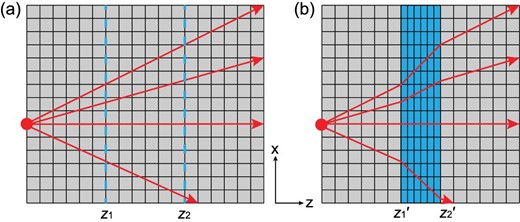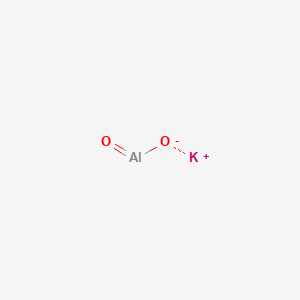SECTION 1. IDENTIFICATION
Product Name: Potassium Aluminate Solution
Product Number: All applicable American Elements product codes, e.g. K-ALO-01-SOL
CAS #: 12003-63-3
Relevant identified uses of the substance: Scientific research and development
Supplier details:
American Elements
10884 Weyburn Ave.
Los Angeles, CA 90024
Tel: +1 310-208-0551
Fax: +1 310-208-0351
Emergency telephone number:
Domestic, North America: +1 800-424-9300
International: +1 703-527-3887
SECTION 2. HAZARDS IDENTIFICATION
2.1 Classification of the substance or mixture:
Directive 67/548/EEC: Corrosive; R35
Regulation (EC) No 1272/2008: Met. Corr. 1, Skin Corr. 1A and Eye
Damage 1
The most important adverse physicochemical, human health and environmental effects:
Potential health effects: Exposure may cause burns.
Potential environmental effects: Large concentrations raise the pH value in water environments.

2.2. Label elements:
Signal word: Danger
Hazard pictogram: GHS05
Hazard statements:
H290: May be corrosive to metals.
H314: Causes severe skin burns and eye damage.
Precautionary statements:
P280:
Wear protective gloves/protective clothing/eye protection/face protection.
P302+P352: IF ON SKIN: Wash with plenty of soap and water.
P305+P351+P338:
IF IN EYES: Rinse cautiously with water for several minutes. Remove contact lenses, if present and easy to do. Continue rinsing.
P310: Immediately call a POISON CENTER or doctor/physician.
P405:
Store locked up.
P501:
Dispose of contents as dangerous waste/container to recycling or incineration.
2.3. Other hazards:
The substance does not meet the criteria for PBT or vPvB in accordance with Annex XIII of the regulation.
There are no other hazards than the ones listed above.
SECTION 3. COMPOSITION/INFORMATION ON INGREDIENTS
3.1. Substances:
63 % Potassium Aluminate
37 % Water
SECTION 4. FIRST AID MEASURES
4.1.
Description of first aid measures:
Eye contact: Rinse immediately with water at least 15 minutes.
Continue rinsing until medical assistance is obtained.
Skin contact: Remove polluted clothing and wash thoroughly with soap and water.
Inhalation: Place victims in fresh air, rinse nose and mouth with water. Get medical assistance.
Ingestion: Rinse the mouth with water and drink plenty of water. Get medical assistance.
4.2. Most important symptoms and effects, both acute and delayed:
Acute: Pain because of burning.
Delayed: The burning will continue if you do not rinse long enough with water.
4.3. Indication of any immediate medical attention and special treatment needed:
Look at section 4.1.
SECTION 5. FIREFIGHTING MEASURES
5.1. Extinguishing media:
The product is not inflammable.
5.2. Special hazards arising from the substance or mixture:
When heating caustic steams which are heavier than air are generated.
5.3 Advice for fire-fighters: A respirator is to be used during indoor fire.
SECTION 6. ACCIDENTAL RELEASE MEASURES
6.1.
Personal precautions, protective equipment and emergency procedures:
Avoid skin contact with the product(see section 8).
6.2.
Environmental precautions:
Avoid spillage to drain, surface water, groundwater and soil.
6.3
. Methods and materials for containment and cleanup:
Contain a spill–e.g. by covering of drains.
After spillage /leakage absorb with granulate, soil or sand and dilute and wash down with
water. After drain spill or drain leak dilute with plenty of water and report to local authorities. After spillage on ground and/or in streams, report to local authorities.
Do not neutralize with acids, as the product precipitates as a hard and white substance.
6.4. Reference to other sections:
Refer to section 8 for personal protection and section 13 for disposal of granulate used for absorption.
SECTION 7. HANDLING AND STORAGE
7.1 Precautions for safe handling:
Avoid direct contact with the substance (see section 8).
Avoid spillage, splashes and aerosols.
Wash hands after handling the substance and before eating/drinking.
7.2. Conditions for safe storage, including any incompatibilities:
Do not store in containers made of aluminium or their alloys.
The substance must not come in contact with water before processing because of risk of precipitation.
7.3. Specific end use:
Flocculation/coagulation (e.g. drinking and waste water treatment) and in production of catalysts.
SECTION 8. EXPOSURE CONTROLS/PERSONAL PROTECTION
8.1 Control parameters:
Threshold limiting value: Aluminum, dissolved salts, measured as Al: 1 mg/m3.
Potassium hydroxide: 2 mg/m3(peak value).
Carry out exposure control measures to observe limiting value.
DNEL: No data available
PNEC: Aqua (freshwater) = No data available
Aqua (marine water) = No data available
Aqua (intermittent releases) = No data available
Sediment = No data available
8.2. Exposure controls:
No data available.
Appropriate engineering controls:Occupational exposure measurements.
Individual protection measures, such as personal protective equipment:
Avoid direct contact with the substance.
Eye/face protection: Protect eyes with approved goggles or face shield. Access to eye wash stations and, if relevant, an emergency shower is required.
Skin protection: Protect skin with chemical resistant protective gloves, clothes with long sleeves and long legs, protective shoes and if necessary an apron.
Respiratory protection:
When handling generated steam/aerosols, sufficient ventilation is required. If sufficient ventilation is not obtainable, approved respirator with filter type P2 is required.
Thermal hazards:
When heating caustic steams which are heavier than air is generated. A respirator is to be used during indoor fire.
Environmental exposure controls:
Avoid all outlets into drainage system / ground –e.g. by establishing a drip plate or basin.
SECTION 9. PHYSICAL AND CHEMICAL PROPERTIES
Appearance: Light yellow liquid
Odor: Odorless
pH: 12-13
Boiling point: c 115 °C
Density: c 1.54kg/l (20 °C)
Melting point: -
Solubility: Soluble in water
Viscosity: 35cP (25 °C)
Flash point: N/A
Vapor pressure: N/A
Auto-ignition temperature: None
Explosive properties: None
Oxidising properties: None
SECTION 10. STABILITY AND REACTIVITY
10.1. Reactivity:
The substance reacts with acids and forms heat.
10.2. Chemical stability:
3 month under normal conditions.
10.3. Possibility of hazardous reactions: Refer to section 10.1 and 10.5.
10.4. Conditions to avoid:
The substance must not come in contact with water before processing because of risk of precipitation.
10.5. Incompatible materials: The substance reacts with some metals (e.g. aluminium,
magnesium, tin, zinc or their alloys).
10.6. Hazardous decomposition products: The substance is inorganic. It reacts with water and
forms Al(OH)3 and K+. Neither is hazardous.
SECTION 11. TOXICOLOGICAL INFORMATION
11.1. Information on toxicological effects:
(a) acute toxicity:
Oral: No data available
Inhalation: No data available
(b) skin corrosion/irritation: Corrosion
(c) serious eye damage/irritation: Serious eye damages
(d) respiratory or skin sensitisation:
No data available
(e) germ cell mutagenicity:
No data available
(f) carcinogenicity:
No data available
(g) reproductive toxicity: No data available (to see an effect intake must be higher than
100 mg Al/kg bw/day, which is unlikely because of the high corrosiveness of the product).
(h) STOT-single exposure: No data available
(i) STOT-repeated exposure: No data available
(j) aspiration hazard:
No data available
11.2
Information on likely routes of exposure:
Ingestion:
Corrosive and irritating to mucous membranes in mouth and throat.
Inhalation:
Aerosols causes corrosion and irritation to respiratory passages.
Skin/eye exposure:
Corrosive and irritating to skin/eye including redness, pain and risk of ulceration
11.3
Delayed and immediate effects as well as chronic effects from short and long-term exposure:
After exposure to the skin, some time may pass before the irritation is felt. Damage to sight and gullet may be permanent.
11.4
Interactive effects:
No data available.
SECTION 12. ECOLOGICAL INFORMATION
12.1
Toxicity:
No data available.
12.2
Persistence and degradability: The substance is inorganic. By reaction with water insoluble
Al(OH)3 and K+is formed. In wastewater treatment plants the substance precipitates as Al(OH)3
or AlPO4.
12.3
Bioaccumulative potential: No data available. On behalf of known data about aluminium it has been estimated that the bio-accumulative potential in water environments at neutral pH is low (estimated steady state bio-concentration factor (BCFs) for Al is 215 at pH 5.3, 123 at pH
6.1 and 36 at pH 7.2).
The bio-accumulative potential for Al in soil is also expected to below.
12.4
Mobility in soil: The substance is not stable in nature. By reaction with water insoluble Al(OH)3
and K+is formed.
12.5
Results of PBT and vPvB assessment: The substance is not included.
12.6
Other adverse effects: Product may raise the pH value in water environments and is harmful in large concentrations.
SECTION 13. DISPOSAL CONSIDERATIONS
The product is to be disposed of according to regulations on chemical disposal, and therefore
it must not be led into the sewer. The product may be returned to the manufacturer if a
previous arrangement has been made. Packing (cans and tanks) is to be recycled or
incinerated.
SECTION 14. TRANSPORT INFORMATION
The substance must be transported according to regulations for dangerous goods.
14.1
UN number: 1719
14.2 Proper shipping name:
CAUSTIC ALKALI LIQUID, N.O.S. (Potassium aluminate solution)
14.3
Transport hazard class(es):
ADR/RID:
Class 8
IMDG:
Class 8
IATA:
Class 8
14.4
Packing group: II
14.5
Environmental hazards: Require no labelling
14.6
Special precautions for user: No
14.7
Transport in bulk according to Annex II of MARPOL 73/78 and the IBC Code:
Not relevant
SECTION 15. REGULATORY INFORMATION
15.1
Safety, health and environmental regulations/legislation specific for the substance or mixture:
Persons below 18 years are not allowed to work with the product.
15.2
Chemical safety assessment:
No data available.
16.
Other information:
Changes:
Registration in REACH 29.05.2013 –use only under strictly controlled conditions.
R-phrase:
R 35:
Causes severe burns(all hazard statements and precautionary statements have been stated in full in section 2).
Advice/training:
Employees are to be instructed thoroughly before handling the product.
SECTION 16. OTHER INFORMATION
Safety Data Sheet according to Regulation (EC) No. 1907/2006 (REACH). The above information is believed to be correct but does not purport to be all inclusive and shall be used only as a guide. The information in this document is based on the present state of our knowledge and is applicable to the product with regard to appropriate safety precautions. It does not represent any guarantee of the properties of the product. American Elements shall not be held liable for any damage resulting from handling or from contact with the above product. See reverse side of invoice or packing slip for additional terms and conditions of sale. COPYRIGHT 1997-2022 AMERICAN ELEMENTS. LICENSED GRANTED TO MAKE UNLIMITED PAPER COPIES FOR INTERNAL USE ONLY.
 Aluminum's name is derived from alumina, the mineral from which Sir Humphrey Davy attempted to refine it from in 1812. Aluminum was first predicted by Antoine Lavoisier 1787 and first isolated by Hans Christian Øersted in 1825. Aluminum is a silvery gray metal that possesses many desirable characteristics. It is light, nonmagnetic and non-sparking. It stands second among metals in the scale of malleability, and sixth in ductility. It is extensively used in many industrial applications where a strong, light, easily constructed material is needed.
Aluminum's name is derived from alumina, the mineral from which Sir Humphrey Davy attempted to refine it from in 1812. Aluminum was first predicted by Antoine Lavoisier 1787 and first isolated by Hans Christian Øersted in 1825. Aluminum is a silvery gray metal that possesses many desirable characteristics. It is light, nonmagnetic and non-sparking. It stands second among metals in the scale of malleability, and sixth in ductility. It is extensively used in many industrial applications where a strong, light, easily constructed material is needed.  Although it has only 60% of the electrical conductivity of copper, it is used in electrical transmission lines because of its light weight. Pure aluminum is soft and lacks strength, but alloyed with small amounts of copper, magnesium, silicon, manganese, or other elements, it imparts a variety of useful properties.
Although it has only 60% of the electrical conductivity of copper, it is used in electrical transmission lines because of its light weight. Pure aluminum is soft and lacks strength, but alloyed with small amounts of copper, magnesium, silicon, manganese, or other elements, it imparts a variety of useful properties. See more Potassium products.
See more Potassium products. In its elemental form, potassium has a silvery gray metallic appearance, but its
In its elemental form, potassium has a silvery gray metallic appearance, but its 
